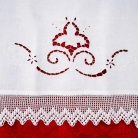Sjećanja izvezena u Balama - Memories embroidered in Bale
Women's handicrafts in Istria are primarily reflected in the decoration of usable textile items.
Usable objects were simply decorated with a monochrome connection in accordance with the economic circumstances of the late 19th and early 20th century. And it is this period that the interesting exhibition taking place in the town of Bale covers. Items once owned by Bale families convey deep social values that have been kept for generations, thus representing a common cultural heritage.
Women from Bale used to decorate towels, bed linen, nightgowns and underwear, children's clothes, ornaments for kitchen hoods and curtains. The lack of free time and financial means limited the ornaments to the "necessary", but there was not a girl who did not prepare her wedding trousseau, beginning with bed linen and the "buon giorno" towel should there be need of a sudden visit from a doctor, extending to the "sugaman dei morti" used to cover their dearly beloved and honouring the deceased and the whole family.
The manual work of Istrian women, apart from functionality, followed the yearly and daily cycle of customs to a greatest extent. This thread is also followed in this exhibition. The technical and aesthetic simplicity of the exhibited items presented, tell the tale of a difficult, laborious life and the power of folk art that goes beyond everyday life, becoming part of history.
Nuns taught young girls their embroidery skills. Along with work in the field, helping in the home and learning at school, it was also necessary for them to learn how to embroider in order to prepare their own trousseau.
Preparation of the trousseau and wedding
One of the breaking moments in each girl's life was marriage. Girls would prepare for that day from the earliest age. They had to prepare the "every day" bed linen and at least one other ceremonial set for the first wedding night, of course. Towels were used mainly during doctor's visits or during childbirth or in case of illness, and were therefore specially adorned. The wealth of the trousseau was reflected in the number of objects and the elaboration of the decoration on them. The most common was white embroidery using a flat stitch and a cross stitch to create initials and the inscription "Buon giorno" on the towels. Although less often, lace was made using a knitting, unfolding technique or bought lace was sewn onto a canvas. Although there were earlier cases, especially in wealthy families, from the mid 20th century a girl’s dowry was paid by her parents.













